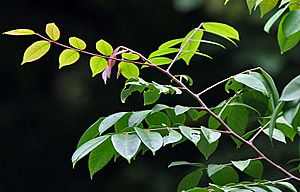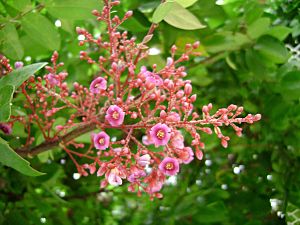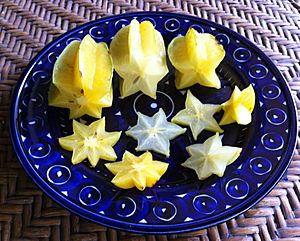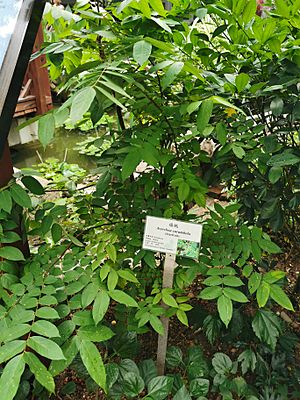Averrhoa carambola facts for kids
Quick facts for kids Averrhoa carambola |
|
|---|---|
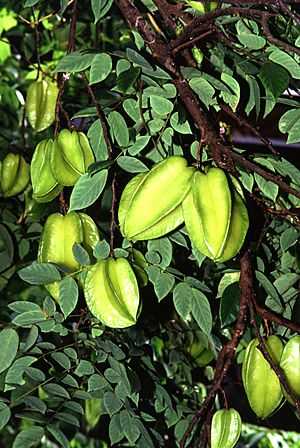 |
|
| Carambolas still on the tree | |
| Scientific classification | |
| Genus: |
Averrhoa
|
| Species: |
carambola
|
The Averrhoa carambola is a type of tree that belongs to the Oxalidaceae family. It is originally from tropical Southeast Asia. This tree is known by several common names, including carambola, star fruit, and five-corner. It is a small tree or shrub that usually grows about 5 to 12 meters (16 to 39 feet) tall. It has pretty rose to red-purple flowers. These flowers are small and bell-shaped, with five petals that have whitish edges. In warm, tropical places, the tree often produces flowers all year round. People grow this tree in tropical and semi-tropical areas because of its tasty, edible fruits.
Contents
What is a Star Fruit Tree?
The Averrhoa carambola is a small tree that stays green all year. It grows slowly and has a short trunk, or it can be more like a shrub. Its branches hang down, and the wood is white, turning reddish over time. The tree has a bushy shape with many branches, forming a wide, rounded top.
Its leaves are soft and medium-green. They grow in a spiral pattern around the branches. Each leaf is made up of several smaller leaflets, usually 5 to 11 of them, arranged almost opposite each other. These leaflets are about 3.8 to 9 cm (1.5 to 3.5 inches) long and have an oval shape. The top side of the leaves is smooth, while the underside is slightly hairy and whitish.
The leaflets are special because they react to light. They tend to fold together at night. They are also sensitive to sudden movements, like when the tree is shaken, and will close up.
The flowers are lilac or purple-streaked and have a soft, fuzzy feel. They grow in small groups at the ends of twigs or sometimes on larger stems and the trunk. Each flower group is attached to the tree with red stalks. The flowers are bell-shaped and about 6 mm (0.24 inches) wide, with five petals that curve back.
The fruits are very eye-catching and have an oblong shape. They have 5 to 6 ridges running along their length, making them look like a star when you cut them across. They are about 6.35 to 15 cm (2.5 to 6 inches) long and up to 9 cm (3.5 inches) wide. The fruit has a thin, waxy skin that is orange-yellow when ripe. Inside, the juicy fruit is yellow and has a crisp texture. Star fruits have a smell like oxalic acid, which can be strong or mild depending on the plant. The taste also varies from very sour to mildly sweet. Each fruit can have up to twelve flat, thin, brown seeds, about 6 to 12.5 mm (0.24 to 0.49 inches) long. Some types of cultivated star fruit have no seeds at all.
How Star Fruit Leaves Move
Did you know that some plants can move quickly? The Averrhoa carambola plant is one of them! Its leaves can move from a flat, horizontal position to a vertical, drooping one in about 20 seconds. This movement happens because of changes in water pressure inside the leaf cells.
When the leaves sense something, like a touch from an animal, it sends an electrical signal. This signal causes certain tiny particles, called ions, to move out of special cells in the leaf. When these ions leave, water also moves out of the cells. This makes the cells shrink, and the leaves droop downwards.
Why do the leaves do this? There are a few good reasons:
- Protection from animals: Some scientists think that when the leaves droop, the plant looks less healthy and appealing. This might make hungry animals choose to eat a different plant instead.
- Saving water: The movement also helps the plant lose less water. Plants have tiny openings called stomata on their leaves, which are like little mouths that take in carbon dioxide for photosynthesis. When the plant needs to save water, special cells around these openings can shrink, closing the stomata. This prevents water from escaping.
- Protecting from the sun: Drooping leaves can also protect the plant from too much sun. When the sun is very strong, the leaves move to a position where they are not directly facing the light. This helps prevent the leaves from getting too hot and protects the plant's ability to turn light energy into food.
Where Star Fruit Grows
The star fruit tree, Averrhoa carambola, first came from tropical Southeast Asia. People have been growing it there for a very long time. It might have been brought to places like India and Sri Lanka by ancient traders.
Even though it's native to Southeast Asia, it's hard to say exactly where it first grew in the wild because it's not found growing wild anymore.
How People Use Star Fruit
The Averrhoa carambola is most famous for its fruit, the star fruit, which gets its name from its star-like shape when sliced. Besides being eaten, the fruit has been used in traditional Asian medicine to help with headaches and other illnesses.
Star fruit contains a substance called oxalate. While it's usually safe in small amounts, too much oxalate can be harmful.
Interestingly, star fruit juice can also be used to remove stains from linen fabric!
Growing Star Fruit Trees
There are many different types of Averrhoa carambola plants. They can have fruits that taste different (some are very sour, others are sweet), have different textures, and even different shapes.
These trees are grown in many countries, including Malaysia, Taiwan, Thailand, Israel, the United States, Brazil, the Philippines, China, Australia, Indonesia, and warmer parts of India. In many of these places, star fruit has become an important crop that farmers grow to sell.
For the flowers to produce fruit, they usually need pollen from another star fruit tree (this is called cross-pollination). This means that plants grown from seeds can be quite different from their parent plants. However, star fruit plants can start flowering and producing fruit about a year after their seeds sprout.
In tropical areas, larger plants can bloom and bear fruit all year round if the weather is good. This means you might see flowers, unripe fruit, and ripe fruit on the same tree at the same time! In other climates, plants usually bloom in the spring and then off and on throughout the rest of the year. Many different types of star fruit are grown, each chosen to have the best flavor and produce the most fruit for specific growing areas.
Important Health Information
Like some other plants in the Oxalidaceae family, star fruit contains a lot of oxalic acid. While this is usually fine for most people in normal amounts, high concentrations can be harmful.
There have been reports of people with kidney problems getting sick after eating star fruit. This is because the fruit contains a substance called caramboxin. Healthy kidneys normally filter this substance out of the body. However, if someone has kidney disease or is on dialysis, their kidneys might not be able to remove caramboxin properly. In these cases, eating star fruit or drinking its juice can cause serious symptoms, and in very rare cases, it can be dangerous. It's very important for anyone with kidney issues to avoid star fruit.
See also
 In Spanish: Asterisa para niños
In Spanish: Asterisa para niños


